Posted: October 30th, 2009 | No Comments »
Last saturday at Citilab in Cornellà, in the outskirts of Barcelona, Nicolas and myself organized a “lift @ home” event during the Urban Labs days.
This one-day long workshop called “Hands on Barcelona’s Informational Membrane helped launch the Ciudad Percibida initiative and is part of a series of seminar about the new practices as well as the visions and issues around the hybridization of the digital and the physical in cities (upcoming November 9 in Geneva: Urban informatics / Les nouveaux paysages numériques). In this event, we focused on the informational membrane hovering over Barcelona and try to sketch near-future scenarios with datasets and infrastructures existing in city. The goal was to understand a contemporary urban software infrastructures and explore the implications (trade-offs, opportunities and concerns) in the data they generate. The effort was put on Barcelona’s specific issues (e.g. mobility, infrastructure, tourism, gentrification, ecology …) and their related datasets.
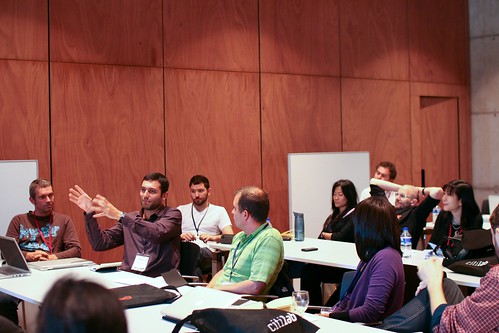
We had a group of 30 participants coming from very diverse backgrounds: designers, engineers, people from the city of Barcelona, ethnographers, architects, etc. both from the area and abroad. We started from a presentation&discussion about the general problems of Barcelona and the available data. Then small groups have been formed to work on how to use the existing infrastructures and data to create potential solutions in terms of services. The assignments led people to go beyond traditional techno-determinism to envision social and organizational framing.
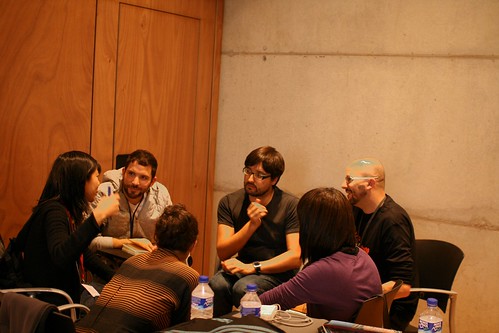
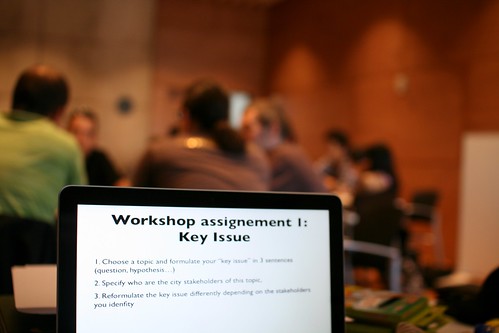
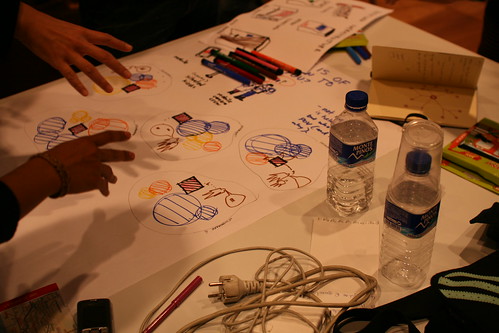
We’re working on a short write-up document for this workshop. Something that would summarize the findings and pave the way for upcoming seminars.
Posted: October 20th, 2009 | No Comments »
On Saturday October 24, Lift lab will run the workshop “Hands on Barcelona’s Informational Membrane” at Citilab in Cornellà (Barcelona) in the last day of Urban Labs. Our first workshops that aimed at discussing the new practices (see Round table on Real-Time Cities at MIT) and the visions and issues (see The Design of the Hybrid City of the Near Future at Lift09) behind the concept of hybrid cities. This time, we will try to go beyond abstract discussions and far-fetched visions. The 25 participants will focus on the informational membrane hovering over Barcelona and try to sketch near-future scenarios with datasets and infrastructures existing in city. The goals will be to understand a contemporary urban software infrastructures and explore the implications (trade-offs, opportunities and concerns) in the data they generate. With Nicolas Nova, we will use these upcoming days to finalize the format of the workshop, but we will make an extra effort to ground it on Barcelona’s specific issues (e.g. mobility, infrastructure, tourism, gentrification, ecology …) and their related datasets.
Once again, we are particularly proud with the mix of talents and pioneers that will join us.
Prior to the workshop, Adam Greenfield will present his takes on networked cities and hopefully also provoke us on the data networked object generate (see Toward urban systems design). Following-up on the same theme, Ben Cerveny will most certainly take some altitude to discuss design research on urban computational systems (see VURB). We could not think a better pair of inspiring speakers to provoke the rest of the participants who for the main part, are pioneers practically involved with the concepts of digital/hybrid/data/networked/sentient cities:
Mario Ballesteros, independent editor, researcher who I met in his role of curator for the Design Hub in Barcelona, is a regular collaborator at Actar Publishers and writes in his own personal research blog, Mañanarama, on the subject of modern architecture in Mexico as a product of failed development.
Joan Batlle, the Head of Innovation and eGovernment International Cooperation Department of the Barcelona City Council, has been leading many projects applying innovative Technology in government processes, including the Intelligent Cities of the Next Generation project.
Anjalika Bose, working currently in Philips Design Probes, as an Ambient Experience Designer, pushing projects in the realm of architectural spaces (see Design Probes).
Cariou Christophe, an independant researcher and founder of Everydatalab who I met at the World Information City conference where he presented an innovative process of mixing quantitative data (anonymous logs of calls, handovers and sms) with user-generated content to map the Fête de la Musique night in Paris.
Jose Luis De Vicente, a cultural researcher and curator. He directs the Visualizar program at Medialab Prado, Madrid.
Domenico Di Siena, architect and researcher, has been reporting his exploration of the relationship between public space and new technologies on Ecosistema urbano and urbanhumano. He is also actively involved in the development of the Meipi collaborative platform.
Juan Freire, PhD in Biology and Professor at the University of Corunna (UDC) where he acted as Dean of the School of Sciences. Now, he is CEO of Fismare, an environmental consulting firm, and fellow of e-Cultura, a firm devoted to cultural management, territorial development and creative processes. I particularly discovered the uniqueness of Juan at Visualizar when he wore his marin biologist hat and drew comparisons between the ocean and urban environment.
Paco González, architect, works and researches at radarq.net, an open study which works and researches on architecture, city and network (see their projects).
Irene Hwang, an architect and editor, co-founder of Constructing Communication. I met Irene in her role of curator for the Design Hub in Barcelona.
Daniel Kaplan, founder and CEO of the Next-Generation Internet Foundation (Fing), a collective and open Research and Development project that focuses on digital innovation and on the interaction between technological progress, business innovation and societal change
Giles Lane, an artist, researcher and teacher, founder and co-director of Proboscis that has widely been inspiring research in locative media and ubiquitous computing since 1994 (mine included), particularly for their capacity to act on the field with citizens and institutions as well as their creative practice that mix fields as diverse as medical research, music, community development, housing and urban regeneration, pervasive computing, mapping and sensor technologies.
Joachim Neumann, researcher at Telefonica Research who has been developing some unique analysis of the Bicing bike-sharing system in Barcelona (see Sensing and Predicting the Pulse of the City through Shared Bicycling)
Thierry Marcou, director of the Villes 2.0 program (e.g. workshops with citizens and local institutions) that led to the development of the Green Watch / Citypulse platform that encourage people’s implication in measuring environmental indices.
Andrés Ortiz, co-founder of Bestiario dedicated to data dynamic representation and to the creation of digital spaces for the collective creation of knowledge. A pioneer in making the complex comprehensible.
José Luis Pajares, designer and research at Univ. Carlos III de Madrid. He has been working on web interfaces web for location and context-aware mobile devices.”Gelo” also organized of the My Map is not your Map workshop.
Yuji Yoshimura, who I am at Barcelona Ecologia, is now an expert in urban mobility and environmental analysis at Center for Innovation in Transport in Barcelona.
Fortunately, we will benefit from the critical thinking of a couple of participants less involved in practical work on informational membranes:
Nurri Kim, artist and archeologist of the moment, who has recently opened Feeder in Helsinki. This exhibition presents a project dedicated to photographing people that I’ve made custom lunches for (including depictions of the meal that I cooked for them and what they would usually have for their lunch) from 2006 to the present.
Rosa Pera, director of Bòlit, Centre d’Art Contemporani. Girona and director of the master degree “Directing and Designing Exhibition Projects” at Elisava School of Design in Barcelona.
Last but not least, I look forward to meet for the first time Albert Cañigueral, Mathieu Favez, Chris Pinchen, and Lillian Shieh!
Why do I blog this: We hope that this workshop offers an alternative venue to the now omnipresent corporate discourses on self-proclaimed “Smart Cities” and government initiatives on “Open Cities“. With its practical approach, anchored on a specific urban context (i.e. Barcelona), this workshop aims at exploring the implications behind these kinds of initiative, understanding what resources are available and their potentials to improve/prejudice near-future cities. Other similar approaches include Dan Hill’s Urban Sensing course and the upcoming Sentient Rotterdam workshop.
Posted: October 16th, 2009 | 1 Comment »
Idealista has been developing its business in offering the classic online real estate ads platform. The massive amount of information they have been accumulating over the years is transforming them into an urban actor, offering their analysis of the evolution of the real estate market back to the public as well as trends almost in real-time (e.g. el precio de la vivienda usada en españa ya está en niveles de 2005); the kind of report that would take longer to produce through traditional processes. Not only do the analyze the market from the offers (online ads) but they could also evaluate the demand in certain areas of a city from logs on their web server. All this accessible back to the public through their open API.
Now, Idealista offers a call-free number for housing seekers to report any “for rent” or “on sale” sign on the street. If the real estate object is in their database, they will provide all the descriptions and possibly offer the kind of comparative service (i.e. comparing the price with the market) they offer online.

Why do I blog this: Some food for thought for our upcoming workshop ‘Hands on Barcelona’s Informational Membrane‘: An online service, accumulating data on a city transforming into an urban actor, now using crowdsourcing techniques to expend is coverage. Curious to see how this evolves.
Posted: October 13th, 2009 | No Comments »
This blog is now a 6.5 years ‘note to self‘, and will continue so. It contributed to help me frame and polish my thoughts on my research, and will continue so.
Now, A PhD behind me, and Lift lab in front of me, I have paved my next steps, communicating the results of my research and forging new non-academic alliances, to the detriment of contributing blog. Now that my “voice” related to the contributions of my thesis needs a renewal, I am back to a Making/Creating/Building phase (see The Kind of Research I am). I am spending a good share of my time, slightly away from this blog, developing processes and tools to qualify, measure, find utility and extract value from captured urban dynamics. It means moving beyond the fascination around basic capacities to sense or visualize a city in real-time. It means, being humble, working on the ground, understanding clients and partners, their practices and how new tools and techniques can integrate their traditional processes. It means confronting and plotting with bounded disciplines or as Julian Bleecker would say:
“Let things get rather undisciplined and a bit unruly. Disciplines are self-satisfied, with is akin to apathy, which never solved any problems.”
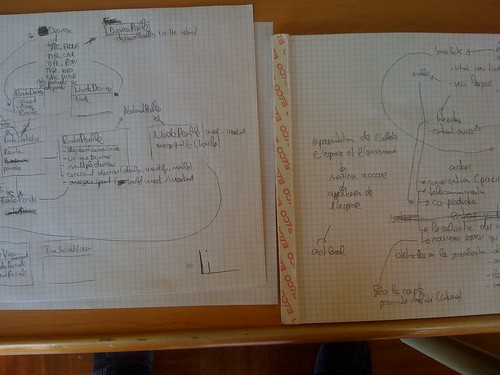
Back to the Making/Creating/Building Phase, contributing on two levels: 1) software/process modeling (making/creating/building); 2) talk planning (polishing a discourse)
Posted: October 13th, 2009 | No Comments »
As part of a conference-debate on “La Terre Vue du Web” organized by Joaquín Keller and Christel Sorin, I gave a talk entitled “Pratiques des nouveaux espaces numériques” (slides in French) to present and debate on the emerging presence of geoinformation, often issued from the Web (expended definition of the Web that includes web protocols and Web of Things) and their implications on contemporary practices in the city. Based on a previous talk, I highlighted the ability to perform a new type of urbanism, based on evidences, merging traditional survey techniques that observes and counts the visible with now developed web analytics tools that measure activities online. This “evidence-based urbanism” provides new means to evaluate and improve strategies, exemplified by our analysis of the digital activity at the New York City waterfront as indicator of urban attractiveness (see study of the New York City Waterfalls).

New practices: merging techniques and tools to observe and measure the urban and the web, the visible and the invisible.
On the other hand, the digital representation of the physical is imperfect and potentially misleading. For instance, satnav system augment our wayfinding capacities with instantaneous contextual and planning information. Taxi drivers must assess and learn their fluctuating quality that must be assessed, leading to an evolution of their practice, sometimes amputating the capacity to learn directly from customers advices.

Evolving practices: assessing the quality of the geoinformation
The debate covered several aspects around the capacity to manipulate previously inaccessible datasets (see From Shoeboxes to Digital Footprints and Digital Shadows, Citizens to Improve Bicing, …), their ability to represent/disform the truth, the use of “sexy” visualizations as part of a research process (see Below the Tip of the Urban Data Iceberg), and their integration into current practices (see Why Real-Time Data Are Not Used to Improve Urban Systems?)
Thanks to Joaquín Keller and Christel Sorin for the invitation!
Posted: October 5th, 2009 | No Comments »
This week, I head to Paris for a gig at La Cantine on the theme “La Terre vue du Web“. I will team-up with Denise Pumain to discuss the ways information, communication and location-aware technologies change our relation with the space. This event is part of a conference series on interdisciplinary approaches to the Web.
Later this month, Lift lab will run a workshop in Barcelona “Hands on Barcelona’s Informational Membrane” that aims at exploring the implications and opportunities of the presence of the informational membrane hovering over Barcelona. The list of participants is already utterly promising.
Finally, I will mingle with tourism professionals and experts at the First International Conference on the Measurement and Economic Analysis of Regional Tourism in San Sebastian, presenting new instruments for measuring and modelling tourism flows and other types of innovation in the tourism enterprise. After the 9th International Forum on Tourism Statistics at OECD, I am thrilled to once again participate to a conference sponsored by the UNWTO with practitioners and people who perform studies on the field.

Back on the road again
Why do I blog this: Thriving from the rich diversity of contiguous domains, languages and perspectives.










